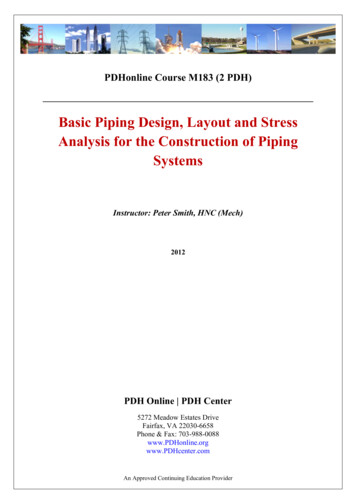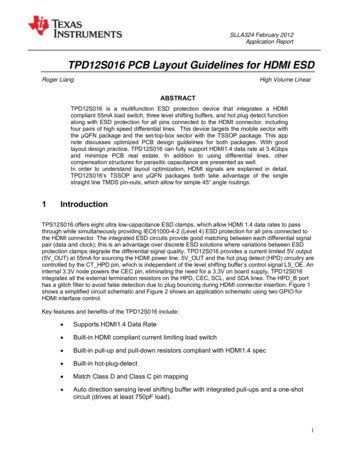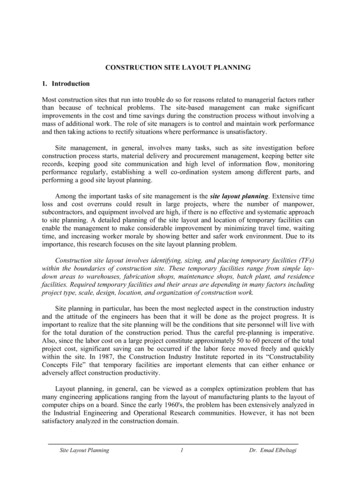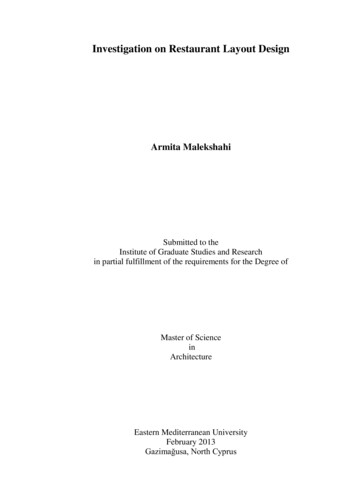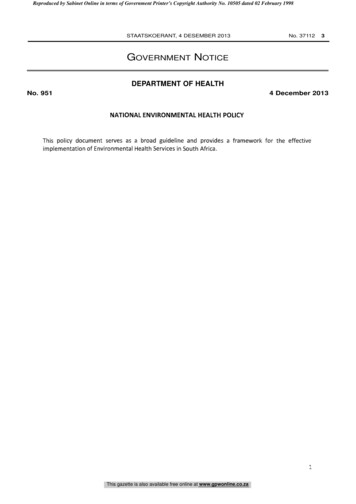
Transcription
Reproduced by Sabinet Online in terms of Government Printer’s Copyright Authority No. 10505 dated 02 February 1998STAATSKOERANT, 4 DESEMBER 2013No. 371123GOVERNMENT NOTICEDEPARTMENT OF HEALTHNo. 9514 December 2013NATIONAL ENVIRONMENTAL HEALTH POLICYThis policy document serves as a broad guideline and provides a framework for the effectiveimplementation of Environmental Health Services in South Africa.1This gazette is also available free online at www.gpwonline.co.za
Reproduced by Sabinet Online in terms of Government Printer’s Copyright Authority No. 10505 dated 02 February 19984No. 37112GOVERNMENT GAZETTE, 4 DECEMBER 2013NATIONALENVIRONMENTAL HEALTH POLICYhDepartment:HealthREPUBLIC OF SOUTH AFRICAThis gazette is also available free online at www.gpwonline.co.za
Reproduced by Sabinet Online in terms of Government Printer’s Copyright Authority No. 10505 dated 02 February 1998STAATSKOERANT, 4 DESEMBER 2013No. 37112Table of contentsPagePreamble3PrefaceList of acronyms6Definition of terms6Executive summary9Section 1:Introduction and Background10Section 2:Scope of Applicability11Section 3:Purpose of the Policy11Section 4:Policy Goal, Objectives and Guiding Principles11Section 5Health Sector Mission14Section 6:Constraints and Opportunities14Section 7:Setting the Context15Section 8:Strategies to Achieve Policy Objective23Section 9:Governance and Institutional Framework for Policy Implementation30Section 10:Approaches for the implementation of Environmental HealthPriority Programmes33Section 11:Environmental Health Forums38Section 12:Research and Development38Section 13:Monitoring and Evaluation39Section 14:Strategy for Policy Implementation40This gazette is also available free online at www.gpwonline.co.za5
Reproduced by Sabinet Online in terms of Government Printer’s Copyright Authority No. 10505 dated 02 February 19986No. 37112GOVERNMENT GAZETTE, 4 DECEMBER 2013PREAMBLE by Minister of HealthtwarThe National Development Plan (NDP) of the country is aimed at eliminatingpoverty and reducing inequality by 2030, with the promotion of health and provision of quality health carefor all South Africans being amongst the key priority areas. In 2010, the government adopted a newoutcome based approach to accelerate the achievement of the objectives outlined in the Medium TermStrategic Framework (MTSF) for 2009-2014. Amongst the goals of the MTSF is improving the healthstatus of the South African Population. As a result the National Department of Health adopted a 10-pointplan for the health sector, aimed at promoting an accessible, caring and high quality health system thatwill contribute to government's vision of "A Long and Healthy Life for All South Africans". This willonly be possible by broadening and deepening the extent and scope of community involvement andsocial mobilisation in all aspects of health provision at local level.South Africa is a fast developing country with a growing economy, and to the rest of the world, this is agateway into Africa. The country's health sector is however, still faced with challenges. South Africacurrently faces a quadruple Burden of Disease (BoD) consisting of HIV and AIDS and TB, High Maternaland Child Mortality, Non-Communicable Diseases and Violence and Injuries. Diarrhoea and respiratorydiseases are still amongst the top causes of death in the country, and Malaria, although being eradicatedin most of the provinces, is still a problem in some parts of the country. Strengthened EnvironmentalHealth Services will contribute greatly to this focus. The contributing factors to environmental relateddiseases in South Africa include poor hygiene and sanitation practices due to lack of adequate sanitationfacilities, poor management of waste, pollution of water and contaminated ambient air. The effects ofclimate change are becoming a global problem, and South Africa is not an exception. With a potential toimpact negatively on food production, water availability, migration and political conflict, climate changerequires global intervention.The country's health system renewed focus on primary health care calls for effective health promotionand illness prevention interventions, as opposed to the previous curative focused health system whichproved to be unsustainable, expensive and destructive as people tend to depend on the health systemfor better health rather than on improving own health. South Africa has both financial and technicalresources to strengthen Environmental Health services as a critical preventative health programme tosignificantly contribute to addressing the MDGs, especially MDG 4, 5, 6, and 7. Adequate financial,human and material resources are very essential for effective environmental health services and theThis gazette is also available free online at www.gpwonline.co.za
Reproduced by Sabinet Online in terms of Government Printer’s Copyright Authority No. 10505 dated 02 February 1998STAATSKOERANT, 4 DESEMBER 2013No. 371127achievement of policy objectives. Budgetary allocation to should be improved at all administrative levels,in order that the department can meet its health services obligation, especially on environmental healthside.The success of the department in delivery health services related to environmental health is dependenton improved cooperation and collaboration with other government departments, the private sector andthe community at large.This policy is a piece of wire that will assist in capitulating environmental health status to great heights.When environmental health receives attention, we are rest assured that the health and safety has beenfortified. We cannot be successful in achieving a long and healthy life unless environmental healthservices receive the attention it deserves.OALEDI, MPTER OFDATEEALTH97)IThis gazette is also available free online at www.gpwonline.co.za
Reproduced by Sabinet Online in terms of Government Printer’s Copyright Authority No. 10505 dated 02 February 19988No. 37112GOVERNMENT GAZETTE, 4 DECEMBER 2013PREFACEhe National Environmental Health Policy will serve as a framework within whichEnvironmental Health Services in South Africa should be rendered and implemented. The policy will alsoprovide opportunity for guidance with regards to development of environmental health service deliveryplans for Municipalities. The Policy was formulated through an extensive and participative consultationprocess with Provinces, Municipalities, Institutions of Higher Learning, WHO, and other organisationswithin the environmental health fraternity. The National Department of Health would like to express itsgratitude and appreciation for their valuable and insightful contributions to the realisation of thisdocument.Environmental health aspects in South Africa are multi-sectoral, with some functions cutting acrossvarious government departments, which has in some cases resulted in duplication of institutional rolesand responsibilities. The need to establish a Health and Environment Strategic Alliance to promoteenvironmental cooperative governance amongst government departments is therefore justified. This willalso give effect to the Libreville declaration of 2008 which was endorsed in the Luanda commitments byMinistries of Health and Environment in Africa in November 2010. These collaboration and coordinationefforts will contributetowards meeting the MDGs related to environment and health. The NegotiatedService Delivery Agreement (NSDA) between Health and Water and Environmental Affairs was a step inthe right direction towards achieving synergy in this regard.DOH will furthermore engage in a process of strategy development to provide a supportive basis forachieving the environmental health policy requirements.MS MP MATSOSODIRECTOR- ENERAL: HEALTHDATE:i 5---2,c2This gazette is also available free online at www.gpwonline.co.za
Reproduced by Sabinet Online in terms of Government Printer’s Copyright Authority No. 10505 dated 02 February 1998STAATSKOERANT, 4 DESEMBER 2013LIST OF ACRONYMSAIDSAcquired Immune Deficiency SyndromeCoGTADepartment of Cooperative Governance & Traditional AffairsDAFFDepartment of Agriculture, Forestry and FisheriesDHISDistrict Health Information SystemDEADepartment of Environmental AffairsDMDistrict MunicipalitiesDMRDepartment of Mineral ResourcesDOHDepartment of HealthDOTDepartment of TransportDWADepartment Water AffairsEHEnvironmental HealthEHPEnvironmental Health PractitionerEHISEnvironmental Health Information SystemEHSEnvironmental Health ServicesHIVHuman Immunodeficiency VirusHPCSAHealth Professions Council of South AfricaIHRInternational Health RegulationsILOInternational labour OrganisationIDPIntegrated Development PlansM&EMonitoring and EvaluationMDGMillennium Development GoalsMDR-TBMulti Drug Resistant TuberculosisMHSMunicipal Health ServicesMMMetropolitan MunicipalitiesMRCMedical Research CommissionNEMANational Environmental Management Act, Act 107 of 1998NHANational Health Act, Act 61 of 2003NSDANational Service Delivery AgreementPHASTParticipatory Health and Sanitation TransformationPHCPrimary Health CareRDPReconstruction Development ProgrammeSADCSouthern African Development CommunitySANASituation Analysis and Needs AssessmentSDBIPService Delivery and Budget Implementation PlansSETASector, Education and Training AuthoritySTATSSAStatistics South AfricaTBTuberculosis306095—BThis gazette is also available free online at www.gpwonline.co.zaNo. 371129
Reproduced by Sabinet Online in terms of Government Printer’s Copyright Authority No. 10505 dated 02 February 199810No. 37112GOVERNMENT GAZETTE, 4 DECEMBER 2013UNEPUnited Nations Environment ProgrammeWHOWorld Health OrganizationWILWork Integrated LearningWSSDWorld Summit on Sustainable DevelopmentXDR-TBExtensively Drug Resistant TuberculosisDEFINITION OF TERMSFor the purpose of this Policy, herein referred to as the National Environmental Health Policy, thefollowing definitions will apply;Communicable Disease means communicable disease as defined in the National Health Act, 2003,(Act No. 61 of 2003);Constitution means the Constitution of the Republic of South Africa, 1996 (Act No. 108 of 1996Environment means the surroundings within which humans exist and that are made up of:a)b)c)d)The land, water and atmosphere of the earth,Micro-organisms, plant and animal life,Any part or combination of (a) and (b) and the interrelationships among and between them,The physical, chemical, aesthetic and cultural properties and conditions of the foregoing thatinfluence human health and well-being;Environmental Health encompasses those aspects of human health, including quality of life that isdetermined by physical, chemical, biological, social and psychosocial factors in the environment. It alsorefers to the theory and practice of assessing, correcting, controlling and preventing those factors in theenvironment that can potentially affect adversely the health of present and future generations.Environmental Health Assistant means, subject to the provisions of the Health Professions Act, 1974(Act No. 56 of 1974) as amended, any person registered as such with the Health Professions Council ofSouth Africa.Environmental Health Practitioner means, subject to the provisions of the Health Professions Act,1974 (Act No. 56 of 1974) as amended, any person registered as such with the Health ProfessionsCouncil of South Africa, and includes an Environmental Health Practitioner doing compulsory communityservice.Environmental Health Services means the assessment, monitoring, correction, control and preventionof environmental factors that can adversely affect human health. It includes but not limited to anticipationand identification of environmental health hazards and risks regarding:a)b)c)d)e)f)g)h)i)j)k)Water quality monitoring,Food control,Waste management,Surveillance of premises,Communicable diseases control,Vector control,Environmental pollution control,Disposal of the dead,Chemical safety and noise control,Port Health, andMalaria Control;This gazette is also available free online at www.gpwonline.co.za
Reproduced by Sabinet Online in terms of Government Printer’s Copyright Authority No. 10505 dated 02 February 1998STAATSKOERANT, 4 DESEMBER 2013I)m)No. 3711211Hazardous Substances controlAir Quality ManagementEnvironmental Health Worker for the purpose of the policy means an Environmental HealthPractitioner, an Environmental Health Practitioner doing compulsory community service, or anEnvironmental Health Assistant.Hazardous Substances means any substance which may cause injury or ill-health to or death of humanbeings by reasons of their toxic, corrosive, irritant, strongly sensitizing or flammable nature or thegeneration of pressure thereby in certain circumstances. This includes hazardous chemical substancesand such substances as solid, liquid, gas, aerosol or combinations thereof, but excludes hazardouselectronic products;Health means a state of complete physical, mental and social well being, and not merely the absence ofdiseases or infirmity;Health Nuisance means health nuisance as defined in the National Health Act 2003, act 61 of 2003Health Services means:b)Health care services, including reproductive health care and emergency medical treatment,contemplated in section 27 of the Constitution,Basic nutrition and basic health services contemplated in section 28(1)( c) of thec)d)Constitution,Medical treatment contemplated in section 35 (2) (e) of the Constitution,Municipal health services;a)Minister of Health means the Cabinet member responsible for health;Municipal level/ Municipality shall refer to both District and Metropolitan Municipalities.Municipal Health Services means Municipal Health Services as defined by Section 1 of the NationalHealth Act, 2003 (Act No. 61 of 2003), and the Constitution of South Africa, Act 108 of 1996;Department of Health refers to the National Department of Health;Pollution - means pollution as defined in section 1 of the National Environmental Management Act,1998 (Act No. 107 of 1998);Premises means premises as defined in the National Health Act, (Act. 61 Of 2003)Stakeholder means individuals and groups concerned with or affected by the environmentalperformance of an organization;This gazette is also available free online at www.gpwonline.co.za
Reproduced by Sabinet Online in terms of Government Printer’s Copyright Authority No. 10505 dated 02 February 199812No. 37112GOVERNMENT GAZETTE, 4 DECEMBER 2013EXECUTIVE SUMMARY / PREAMBLEThe National Policy on Environmental Health reflects the Government's intent as far as renderingEnvironmental Health Services is concerned. It is subject to the broader National Health Policy, as setout in the White Paper on the Transformation of Health Services in South Africa, the National Health Act,2003 (Act No 61 of 2003) and the Regulation defining the Scope of the Profession of EnvironmentalHealth 888 of 21 April 1991, as amended.,Government recognises the importance of prevention across all levels of health care. Wherever possiblethe burden ofillhealth and disability must be averted by preventive interventions. This is clearlyindicated in the White Paper on the Transformation of Health Services, as well as the Primary HealthCare (PHC) Alma-Ata. Prevention strategies often need to address adverse environmental factors, aswell as individual behaviour and lifestyle.SUMMARY AND PREFACE OF THE POLICYSection 1 gives a contextual background of the policy and briefly highlights the importance and impactof EHS on the human health. Section 2 outlines the scope of applicability of the policy, whereas Section3 sets out the purpose of this Policy and reflects on the importance and necessity of the Policy. Section4 highlights the constraints and opportunities in the delivery of EHS in South Africa. Section 5 sets outprinciples to guide policy implementation, Section 6 outlines policy objectives. Section 7 provides themission of the health sector and that of environmental health with regards to the policy. Section 8sketches the international, regional and national context, referring to demographic features, diseaseburden and rights and obligations in terms of the Constitution and international agreements. Section 9outlines the strategies to achieve policy objectives and Section 10 outlines governance and institutionalframework for policy implementation, which clarifies roles of various spheres of government with regardsto provision of EHS. Section 11 highlights EH priority programmes and -guides the implementation ofvarious programmes in the field of environmental health. In Section 12, the issue of improvedcommunication is tackled through EH forums at national and provincial level. Section 13 emphasizes thecritical role of research for improved capacity and development. Section 14 provides for monitoring andevaluation of policy implementation. Lastly, Section 15 indicates the intention of a strategy developmentto ensure effectiveness in policy implementation.9This gazette is also available free online at www.gpwonline.co.za
Reproduced by Sabinet Online in terms of Government Printer’s Copyright Authority No. 10505 dated 02 February 1998STAATSKOERANT, 4 DESEMBER 2013No. 3711213INTRODUCTION AND BACKGROUNDSECTION 1:When the Libreville declaration was signed in 2008, it was based largely on the concern that over 23%28% of deathsinAfrica estimated at over 2A million per annum are attributed to avoidableenvironmental risk factors with particular effect on the poorest and the most vulnerable groups of society.The declaration was also based on the emergence of new environmental risks as a result of climatechange, industrial expansion and new technologies which presents new risks to Public Health.The World Health Organization (WHO) estimates that up to 70% of childhood deaths in Africa areattributed to environmental risk factors. According to the Medical Research Council (MRC), the health ofpoor urban people in South Africa is threatened more by environmental degradation caused by others,than it is by their own lifestyle choices. The six major risk areas are inadequate access to safe drinkingwater, poor hygiene and sanitation, disease vectors, air pollution, chemical hazards and unintentionalinjuries.When a population is exposed to environmental hazards, a relationship is established between the levelsof exposure and health outcomes of that particular population. The linkages created between the statusof the environment and human health is thus termed "environmental health". Environmental health is apractice that seeks to protect human health by combating physical, chemical, biological and socialthreats in the environment.Itisthe most fundamental public health approach, affecting wholepopulations and providing a foundation for modern living.Environmental health practice covers theassessment, correction, control and prevention of environmental factors that can adversely affect humanhealth. It encompasses measures necessary to deal with issues such as environmental degradation andclimate change, and with hazards including chemical exposure and contamination of air, water and food.Environmental health practice provides opportunities to enhance health by planning and developinghealth promoting environments that contribute to better health outcomes.South Africa's 284 municipalities span the entire country, both rural and urban and in this sense, theconcurrent governance frameworks for environment and health apply uniformly throughout the country.Since the establishment of new municipalities in 2000, the legislative and institutional development focushas been upon developing the planning and financial frameworks necessary, and for enhancing theinter-governmental cooperation essential for effective functioning with EHS being based mainly atmunicipality level as part of Municipal Health Services (MHS). This policy will go a long way in ensuringthat the implementation of this critical component permeates all spheres of government. This will furtherput both National and Provincial Departments of Health in a pole position to do oversight, support andsupervision of these essential services.ICThis gazette is also available free online at www.gpwonline.co.za
Reproduced by Sabinet Online in terms of Government Printer’s Copyright Authority No. 10505 dated 02 February 199814No. 37112SECTION 2:GOVERNMENT GAZETTE, 4 DECEMBER 2013SCOPE OF APPLICABILITYThis policy applies to government, private institutions, communities, individuals as well as an undertakingof all activities within the Republic of South Africa that may have an impact on the environment andhealth.The implementation of this policy will be in line with Regulation 888 of 26 April 1991, asamended, which defines the Scope of Profession of Environmental Health.SECTION 3:PURPOSE OF THE POLICYIn order to be proactive in preventing environmental hazards from diminishing quality of life of thepopulation, it is necessary to have a comprehensive national policy for environmental health. This policyaims to provide a national framework for the provision of environmental health services in the country,set out the vision for environmental health and influence health outcomes to ensure "A long andhealthy life for all South Africans".Through this policy, government aims to identify development needs in Environmental Health particularlyfor populations which lack awareness and services due to historical imbalances, by outliningenvironmental health services, and through promotion of intersectoral collaboration in the provision ofenvironmental health services by integrating environmental considerations with the social, political anddevelopment needs and rights of all individuals, communities and sectors.SECTION 4:POLICY GOAL, OBJECTIVES AND GUIDING PRINCIPLES4.1 GoatThe overall goal of the Environmental Health Policy is to ensure the right to an "environment that is notharmful to the health and wellbeing of South Africans".4.2 ObjectivesPrevention and reduction of health risks associated with environmental hazards which are the directcauses of the spread of disease and conditions related to environmental health. In this correction,environmental health services should be prioritized by all responsible agencies. This policy thereforeaims at achieving the following objectives:To promote a legal and regulatory framework that ensures mandatory but also supports voluntarycompliance and also facilitates policy implementation by various actors.2.To formulate an institutional framework that enables efficient coordination and collaboration of thevarious sectors and stakeholders that have environmental health related responsibilities.This gazette is also available free online at www.gpwonline.co.za
Reproduced by Sabinet Online in terms of Government Printer’s Copyright Authority No. 10505 dated 02 February 1998STAATSKOERANT, 4 DESEMBER 2013No. 3711215a To ensure an effective institutional capacity for rendering EHS.4.To strengthen the capacity of environmental health personnel to become efficient agents andcatalysts for desired change.5.To adopt a partnership approach with the purpose of facilitating holistic and integrated planning inenvironmental health.6.To facilitate the development and maintenance of an effective Environmental Health ManagementInformation System.7.To strengthen international co-operation on issues affecting environmental health.8.To improve monitoring of environmental health conditions that may impact on the physicalenvironment and human health.9.To promote community participation and development through empowerment in environmentalhealth, to contribute to promotion of own health.10. To contribute to strengthening environmental hygiene programmes as part of disease prevention andhealth promotion.4.3 Principles to guide policy implementationThe overarching principles of this policy on environmental health are those principles as contained in theBill of Rights as enshrined in Chapter 2 of the Constitution of the Republic of South Africa, 1996 (Act No.108 of 1996) and the White Paper on the Transformation of Health Services.Implementation of the National Environmental Health Policy should however be guided by the followingkey principles that are crucial for the achievement of policy objectives:4.3.1 Recognition of equity in environmental health interventionsEnvironmental health interventions should be planned and implemented on an equitable basis, withresource allocation based on the principle of "some for all" rather than "all for some".4.3.2 Prevention central to human healthPrevention should be at the centre of all environmental health action. Prevention may need toaddress both adverse environmental behaviour/practices and adverse health behaviour for improvedenvironments and healthier lifestyles.Prevention should always be viewed as the other side of the same coin with promotion of health.4.3.3 Recognition of differing needs for women, men, children and the elderlyEnvironmental health interventions should respond to the differing needs of women, men, childrenand the elderly. This must apply specifically on the role of women as main users of food, water andsanitation. Gender sensitive studies should be promoted to ensure recognition of needs for thevarious vulnerable members of society.This gazette is also available free online at www.gpwonline.co.za
Reproduced by Sabinet Online in terms of Government Printer’s Copyright Authority No. 10505 dated 02 February 199816No. 37112GOVERNMENT GAZETTE, 4 DECEMBER 20134.3.4 Intersectoral collaboration and coordinationaWhilst the policy recognizes the advantages of having shared responsibilities,itis important thatsuch responsibilities are clear and provided for by the environmental health related legislationestablished to govern the delivery of EHS. In addition, the law should recognize the Department ofHealth as the Ministry responsible for public health and therefore having responsibility for the overallcoordination of policy implementation and the delivery of EHS. A coordinated and collaborated effortby various government departments and other stakeholders is vital in achieving this.4.3.5 DecentralisationEHS must be based on the decentralised model of the district health system for the promotion ofequity, efficiency and effectiveness.This policy takes note of the role played by Municipalities in delivering Municipal Health Services as aresult of devolution of services.4.3.6 Alliance to the government policiesThe implementation of this policy will be in acknowledgement of the principles of Agenda 21 andHealthy Cities approach and be in line with the principles contained in the White Paper on theEnvironmental Management Policy of South Africa, as well as the Batho Pele Principles.4.3.7 Community ParticipationThe principle of community participation recognizes that although the policy is established by thenational government, implementation of the policy should be effected at the levels that involve thecommunity.4.3.8 Placing emphasis on voluntary compliance through awareness and educationAlthough it's a requirement for compliance to national policies and standards on environment andhealth by importers, producers, manufacturers, retailers and communities, environmental healthstrategies should strike an appropriate balance between promotion and education and lawenforcement.Education must be used as a vital tool of building capacity for all stakeholders /role players, to be ableto attain voluntary compliance.4.3.9 Risk analysisStandards and regulations established to enforce environmental health should be underpinned byrisk analysis, which will include a risk assessment through risk identification, quantifying these risksand costing them in order to implement appropriate corrective environmental health interventions.4.2.Risk CommunicationThis gazette is also available free online at www.gpwonline.co.za
Reproduced by Sabinet Online in terms of Government Printer’s Copyright Authority No. 10505 dated 02 February 1998STAATSKOERANT, 4 DESEMBER 2013No. 3711217Dissemination of accurate and up to date information on environmental health risks and theprevention thereof, in order to reduce environmental related health burdens, particularly to thegeneral public, is crucial. Different elements and principles of communicating risks, early warningsand application of methods relevant for various groups of the population are essential in the provisionof EHS. Risk communication needs to be prioritised and budgeted for at municipal and provinciallevel.4.3.11 The Precautionary principleSuccessful prevention or control of environmental health related diseases requires appropriatemeasures underpinned by scientific means.However scientific data is not always available. Aneffective policy works on the principle that "we do not need to know everything to take action", andthus a precautionary measure should be taken to protect human health, where scientific evidencemay not be available.SECTION 5:HEALTH SECTOR MISSION5.1 MissionThe mission statement of the Department of Health (DOH) is "to improve the health status of SouthAfricans through the prevention of illnesses and the promotion of healthy lifestyles and to consistentlyimprove health care delivery system by focusing on access, equity, efficiency, quality and sustainability.Environmental health service areas that are within the strategic plan includes, control of communicabledisease, environmental management and port health, which are components of this policy.The mission of Environmental health is "to improve the health of the environment and the quality of life ofall communities through a sustainable, co-ordinated, integrated, comprehensive, and proactiveEnvironmental Health Service at all spheres of government".SECTION 6:CONSTRAINTS AND OPPORTUNITIESAlthough government has promulgated extensive legislation on health issues over the past 15 (fifteen)years, and that some sectors of government are ad
Executive summary 9 Section 1: Introduction and Background 10 Section 2: Scope of Applicability 11 Section 3: Purpose of the Policy 11 Section 4: Policy Goal, Objectives and Guiding Principles 11 Section 5 Health Sector Mission 14 Section 6: Constraints and Opportunities 14 Section 7: Setting the Context 15 Section 8: Strategies to Achieve .




